Creative and Affordable Bedroom Decoration Ideas

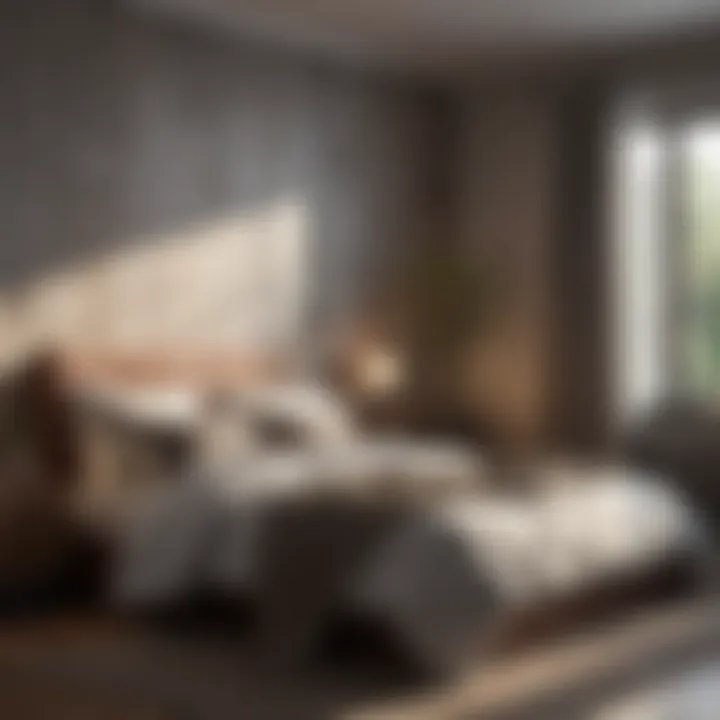
Intro
Transforming a bedroom into a personal sanctuary does not have to be financially burdensome. Creative and affordable decoration ideas can infuse freshness and character into your space without overwhelming your budget. The aim of this article is to provide practical strategies that help in achieving aesthetic and functional transformations for bedrooms. We will walk through various aspects, including design inspirations, functional elements, and various DIY projects that can be implemented with minimal financial investment.
Understanding the balance between creativity and cost-effectiveness will empower homeowners and housewives alike to personalize their space according to their preferences and lifestyle. A well-decorated bedroom is more than just a visual treat; it is a space for rest and rejuvenation.
Design Inspirations
Latest Trends in Bedroom Design
Staying current with design trends is crucial for those looking to revamp their bedrooms. Current trends emphasize simplicity and comfort while integrating nature-inspired elements. Minimalist approaches are popular, focusing on clean lines and neutral colors. Textured fabrics, like linen and cotton, offer warmth and tranquility to the space. A key trend is the use of sustainable materials, which aligns perfectly with budget-friendly goals without compromising style.
Popular choices include:
- Natural wood accents - Introduce wooden shelves or tables for a rustic charm.
- Wall decals - These provide artistic flair without significant costs.
- Houseplants - Incorporating greenery adds life to the room and aids in creating a calming atmosphere.
Color Palettes and Themes
Select a color palette that reflects your personality while promoting relaxation. Soft pastels such as mint green, blush pink, or light blues can create a serene environment. In contrast, deeper shades like navy or forest green can provide a more dramatic effect without being overpowering. It's practical to choose a few complementary colors that can be easily adapted to various decor elements, ensuring cohesion throughout your space.
Consider themes that encapsulate your interests or tastes, such as:
- Bohemian style - Use vibrant patterns and textures to create an eclectic look.
- Scandinavian simplicity - Implement neutral shades along with functional design to enhance comfort.
- Vintage charm - Source second-hand items to create a cozy, nostalgic space.
"A well-chosen color palette and thematic approach adds depth and character to your bedroom."
Functional Elements
Space Optimization Tips
Maximizing space is vital, especially in smaller bedrooms. Start by decluttering. Regularly reassess items in the room, removing unnecessary possessions to free up space. Clever storage solutions are paramount; under-bed boxes can hide winter clothes or shoes, while creative shelving keeps necessities organized and accessible. Also, consider mirrors to create an illusion of spaciousness by reflecting light and visually expanding the room.
Multi-Functional Furniture Choices
Investing in furniture that serves multiple purposes is an effective way to save both space and money. Options such as a bed with built-in drawers or a fold-out desk can transform how you use your space. Consider these pieces:
- Ottomans with storage - Can function as seating while hiding away clutter.
- Convertible sofas - Perfect for accommodating guests while maintaining room flow.
- Wall-mounted desks - Efficiently utilize vertical space without sacrificing surface area.
By thoughtfully integrating these ideas, you can achieve a harmonious bedroom that is both stylish and functional. The journey of decorating your bedroom on a budget opens doors to creativity, allowing you to express yourself uniquely while maintaining financial prudence.
Understanding Budget Decor
When embarking on a bedroom decoration project, understanding budget decor is crucial. It establishes limits and creates a roadmap for any remodel or refresh. This approach allows individuals to infuse their personal style while keeping finances in check. Realizing that creating a beautiful and functional space is not solely dependent on spending a lot of money is a key realization.
Budget decor emphasizes the importance of resource allocation. It encourages thoughtful decisions about where to spend and where to save. Furthermore, embracing a budget can stimulate creativity. Constraints often lead to innovative ideas and unique solutions. By navigating this landscape wisely, one can achieve a well-designed space without overspending.
In the realm of bedroom decoration, two primary factors come to play: defining a decorating budget and identifying essential decorating elements. Together, these elements lay the foundation for an affordable yet stylish bedroom makeover. Let’s delve deeper into these critical aspects to understand how they contribute to effective budget decor.
Defining a Decorating Budget
Establishing a decorating budget is the first step in any effective home improvement project. A clear budget acts as both a guide and a limit, helping to focus choices and prevent excessive spending. Begin by evaluating your financial situation. Consider how much money is available for this specific project.
In defining a budget, it's helpful to outline expected expenses. This includes not only major items like furniture and paint but also smaller costs such as accessories and decor items. Aspects to consider include:
- Furniture: Consider whether you need new pieces or can repurpose existing ones.
- Paint and Wallpaper: Factor in the cost of supplies and tools needed for application.
- Textiles: Budget for bedding and curtains, which can greatly impact the room's aesthetics.
- Accessories: Small items like art and storage solutions also warrant consideration.
It can be beneficial to create a spreadsheet or use budgeting apps to track these costs effectively. This level of detail will help ensure that all elements of the project are accounted for and that the final spending remains within limits.
Identifying Essential Decorating Elements
After defining the budget, identifying essential decorating elements is the next logical step. Not all items require equal importance, and prioritization can lead to more impactful results. Start by evaluating the space itself and its current state. Ask yourself:
- What items are necessary for functionality?
- Which decorative elements will enhance the ambiance?
The distinction between necessity and decor can sometimes blur. Focus on main components such as bedding, furniture placement, and color schemes. Select items based not just on aesthetic preferences but also on their usability.
Additionally, some essential elements for consideration might include:
- Key Furniture: Beds and storage solutions that cater to the room's function.
- Lighting: A mix of ambient, task, and accent lighting can dramatically shift the space's feel.
- Wall Decor: Artwork or personal photos can make a significant style statement.
Ultimately, recognizing and prioritizing these elements can streamline the decorating process, ensuring that funds are allocated to what truly enhances the bedroom's appeal while maintaining a cohesive look and feel.
"The careful blend of necessity with style leads to harmonious living spaces that reflect personal taste without excessive spending."
In summary, understanding budget decor serves as the launching pad for all upcoming decisions in the bedroom redesign process. Through identifying a clear budget and essential elements, readers can engage in mindful decoration practices that yield beautiful results without the stress of financial burden. This approach encourages resourcefulness and creativity, paving the way for successful transformations.
Planning Your Bedroom Makeover
Planning a bedroom makeover is crucial to achieving a space that is both functional and reflective of your personal style. It involves thoughtful consideration of elements like color schemes, furniture arrangement, and decorative accessories. Proper planning provides a roadmap that helps avoid impulsive decisions, which can lead to overspending and cluttered aesthetics.
One significant benefit of planning is that it allows you to set a clear budget. By determining how much you are willing to spend upfront, you can prioritize where to allocate your resources effectively. This financial foresight not only stops overspending but also helps in gathering materials gradually.
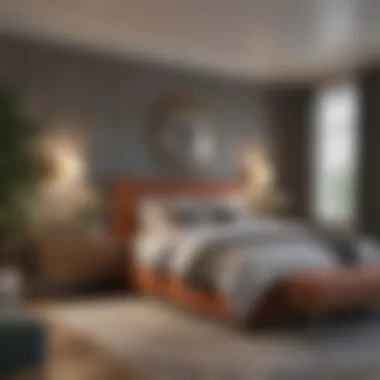
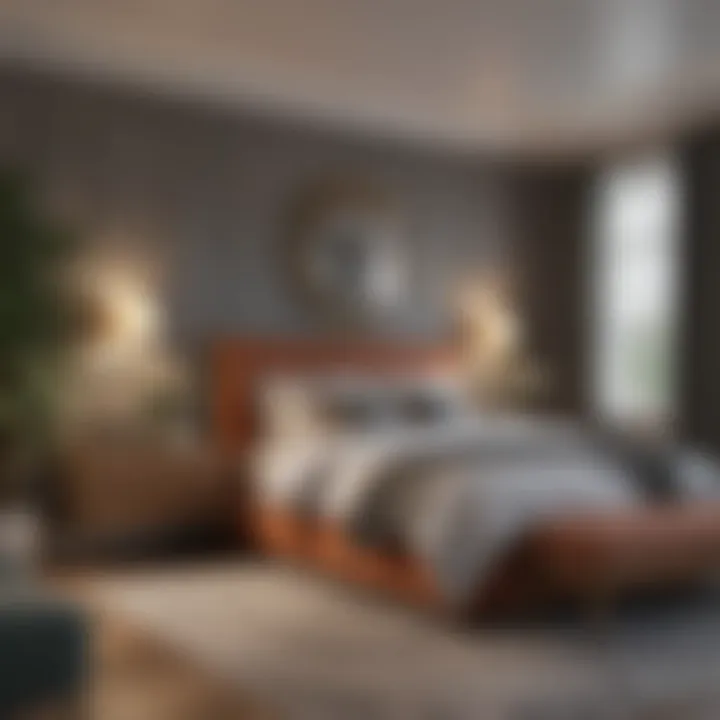
Additionally, a well-structured plan considers the practical needs of your space. A bedroom is not just for sleeping; it serves multiple functions such as a reading nook, a workspace, or a storage area. Therefore, understanding how the space will be utilized will guide the selection of furniture and decor. In a small bedroom, for example, planning can assist in identifying multifunctional furniture or effective storage solutions.
Finally, having a solid plan enhances creativity. When you know the exact elements you want to incorporate, it allows you to experiment with designs and DIY projects without feeling overwhelmed. You can explore ideas that align with your vision, all within your budget.
Creating a Mood Board
Creating a mood board is an excellent first step in planning your bedroom transformation. This visual tool allows you to compile images, textures, and colors that resonate with your desired aesthetic. Tools such as Pinterest or Canva are helpful for digitally assembling your ideas. However, if you prefer a hands-on approach, you might consider using a poster board and magazine clippings.
A mood board serves multiple purposes: it helps clarify your vision, ensures coherence in your decorating choices, and acts as a motivational tool. You can identify trends that appeal to you and evaluate how those styles feel within the overall theme of your bedroom.
Moreover, it allows you to experiment with combinations before making any financial commitment. Imagine having a mix of deep blues and warm wood textures on your board; it gives you a context to visualize if those elements work harmoniously. This process not only sharpens your focus but can also yield a more satisfying final result.
Setting Priorities and Goals
Setting priorities is a critical component of planning your bedroom makeover. After creating a mood board, you may have numerous ideas, but defining what is most important streamlines the decision-making process. Determine which aspects of the bedroom need immediate attention—perhaps the flooring needs updating or the walls require fresh paint. Prioritize these updates based on functionality first and aesthetic appeal second.
Setting specific goals can further enrich the planning phase. These can include objectives like creating an organized space, enhancing comfort, or introducing a certain theme by a deadline. This creates a sense of accountability and urgency that can motivate you to see the project through.
While making these priorities, consider your budget constraints. Aiming high is admirable, but being realistic about what can be accomplished with your financial limits is essential to avoid frustration. In a sense, a balance must be struck between your aspirations and practicality.
By clearly defining your priorities and goals, you can navigate the planning process more effectively and ensure that your bedroom reflects a curated and personal touch.
Utilizing Recycled and Upcycled Materials
Utilizing recycled and upcycled materials is not only a creative approach to bedroom decoration but also an environmentally conscious choice. It helps reduce waste and can often lead to unique and personalized designs that reflect your style. This method encourages innovation and offers various benefits that can transform your bedroom into a stylish sanctuary without breaking the bank.
Finding Value in Second-Hand Items
Discovering hidden gems in second-hand stores or flea markets can be an exciting and fulfilling experience. When you shop for second-hand items, you often find pieces that add character to your space. Items like vintage lamps, antique dressers, or unique artwork can elevate the ambiance of your bedroom. Besides aesthetics, second-hand shopping is budget-friendly. You can acquire quality pieces at a fraction of the retail price.
Consider establishing a routine of visiting local thrift stores. You might stumble upon a forgotten piece that is perfect for your bedroom or serves as an inspiration for your design. When assessing second-hand items, examine them carefully for condition. Look for wear and tear, but also potential. Even if something appears worn, it might be upcycled into a beautiful piece with a little creativity.
Transforming Old Furniture
Old furniture often carries stories and charm that new pieces lack. Instead of discarding dated items, consider transforming them into something new and innovative. For instance, a worn-out dresser could be sanded down, painted, and given new knobs for a fresh look. Likewise, an old bed frame can be revamped with a coat of paint or new upholstery for the headboard.
When planning to upcycle furniture, take a moment to visualize the desired outcome. Collect inspirations from resources like Pinterest or Instagram, which showcase creative transformations. The process might involve some skill, but it can also be a great learning experience.
"Old furniture is not without its value; it can become a canvas for your creativity."
Here are some simple methods for transforming old furniture:
- Painting: Use chalk paint for easy application and a matte finish.
- Reupholstering: Change the fabric on chairs or cushions to breathe new life into them.
- Adding New Hardware: Changing knobs and handles can dramatically change the look of cabinets and dressers.
Exploring Paint and Wallpaper Options
When it comes to transforming a bedroom, paint and wallpaper are fundamental elements that define the space's overall feel. These elements not only affect the color scheme but also influence light, mood, and texture within the room. Selecting the right materials is essential for home owners on a budget, as it offers a way to achieve a fresh look without a hefty expenditure. This section will explore cost-effective strategies to utilize paint and wallpaper creatively.
Choosing Cost-effective Paint Colors
Selecting paint colors might seem simple, yet it carries weighty consequences for the ambiance of a bedroom. Neutral colors, such as whites and beiges, often serve as versatile backgrounds that flow well with various accessories. They also create an illusion of space, making smaller rooms feel larger. For a bolder statement, consider soft pastels or muted tones, which offer personality without overwhelming the senses.
When choosing paint, keep in mind the finish you desire. Matte finishes hide imperfections, while satin and semi-gloss finishes are easier to clean and provide a subtle shine.
Here are important tips when selecting cost-effective paint colors:
- Consider sample pots: Use sample pots to test colors on the wall before committing to large amounts.
- Buy during sales: Paint stores often have sales, particularly during holiday weekends.
- Consider trending colors: Look at color of the year from reputable designers.
These elements can not only enhance appearance but can also stimulate creativity when making decorating decisions.
Budget-friendly Wallpaper Alternatives
Wallpaper can significantly change the decor of a bedroom. However, traditional wallpaper can be expensive, and the installation process can be daunting. Thankfully, there are numerous budget-friendly alternatives that are just as stylish.
For a temporary solution, removable wallpaper has gained popularity. This type can be applied easily, providing flexibility for seasonal changes or trends. Just peel and stick when you feel like a change. Textured wallpaper adds dimension without the commitment of permanent wallpaper, and it is often easy to apply and remove.
Some cost-friendly options also include:
- Wallpaper panels or decals: Use single panels to create a statement wall.
- Fabric or contact paper: These can be applied to furniture or as wall covering.
- DIY techniques: Stenciling or sponge techniques using paint can mimic wallpaper patterns at a fraction of the cost.
Incorporating Textiles and Fabrics
When it comes to bedroom decor, integrating textiles and fabrics can significantly enhance the overall aesthetic and comfort of the space. Textiles play a dual role; not only do they contribute to the visual appeal, but they also serve a practical purpose in creating a cozy environment. The choice of fabrics and textures can define the mood of the room. Proper incorporation can add layers, depth, and warmth, making a bedroom feel inviting.
Selecting Affordable Bedding Options
Selecting bedding is among the most impactful decisions for bedroom decoration. Quality does not always mean spending a fortune. Affordable options often come in aesthetically pleasing designs and high-quality materials. Stores like IKEA and Target offer various bedding lines that don’t compromise on style.
While shopping, consider the following:
- Material: Cotton and linen tend to be breathable and durable.
- Pattern: Striped or floral patterns can make a room look lively without bulk.
- Seasonality: Light colors and fabrics for summer and heavier blankets for winter can enhance comfort.


By investing in a few essential pieces, like a nice duvet cover or a quilt, it is possible to transform the entire look of the bed without breaking the bank.
Creative Use of Curtains and Drapes
Curtains and drapes are another element that merits careful consideration. They help control light and privacy, while also setting a tone for the room. An affordable trick is to opt for fabric that complements existing colors in the room. For instance, sheer curtains can provide an airy feel, allowing natural light to filter in softly. On the other hand, heavier drapes can add a sense of luxury.
When choosing curtains:
- Length: Floor-length curtains create an illusion of taller ceilings.
- Style: Grommet style or rod pocket provides a more streamlined look.
- Fabric: Consider using fabrics that match the season; heavier textures for winter and light fabrics for summer.
Throw Pillows and Blankets: A Cost-Effective Upgrade
Throw pillows and blankets offer an excellent way to introduce color and comfort to a bedroom. They are quite affordable and easy to change according to trends or seasons. Mixing and matching different patterns and textures can create visual interest without cluttering the bed. Furthermore, layering blankets can also provide warmth during colder months.
Some tips for pillows and blankets include:
- Color Coordination: Choose colors that align with the rest of the decor.
- Variety in Textures: Mix fabrics like velvet and cotton to create depth.
- Functionality: Ensure that pillows aren’t just decorative; they should also serve comfort purposes.
"Textiles are a small investment that can have a huge impact on the overall feel of a room."
Incorporating the right textiles and fabrics can undoubtedly enhance a bedroom’s atmosphere while being budget-friendly. It is about making informed selections that reflect personal style without excessive spending.
Accessorizing on a Budget
Accessorizing a bedroom smartly, while minding expenses, can remarkably enhance the overall feel of your space. Accents like artwork, mirrors, and decorative objects play a crucial role in defining the character of a room. Engaging in budget-friendly accessorizing allows homeowners to express their style without financial strain. Each accessory acts as a reflection of personal taste and, when chosen thoughtfully, contributes to a cohesive look.
Important elements include functionality and aesthetics. For instance, a well-placed mirror not only adds style but also makes small spaces appear larger. Additionally, these accents can be changed seasonally or when your taste evolves, bringing freshness without the need for a complete redesign.
DIY Artwork and Wall Decor
Creating your own artwork can be fulfilling and economical. DIY projects enable you to tailor pieces to fit your bedroom's color and style. You can utilize affordable materials such as canvases and paints from local craft stores or even repurpose items you already own. For example, an old frame can house new pictures or fabric scraps.
Here are some ideas for DIY wall decor:
- Canvas Painting: Use simple painting techniques. Abstract designs are easiest and require little skill.
- Photo Collages: Gather personal photos and arrange them in a grid on the wall, creating a personal gallery.
- Fabric Hangings: Use beautiful fabric to create wall hangings that soften and warm the space.
- Mason Jar Displays: Fill mason jars with small items, like pebbles or fairy lights, and mount them for a unique look.
In addition, engaging in fabric art or upcycling older pieces can add character and tell a story specifically tailored to your life experience.
Smart Placement of Mirrors
Mirrors are versatile decorative elements that offer both style and practicality. They can visually expand a room, improve natural light flow, and create focal points. To maximize their effect, consider the placement carefully. Here are some considerations:
- Light Sources: Place mirrors opposite windows to reflect natural light, enhancing brightness around the room.
- Height and Size: Depending on the size of the bedroom, larger mirrors can create an illusion of space. For smaller rooms, a cluster of smaller mirrors can work effectively.
- Decorative Frames: Use mirrors with interesting frames to add texture and charm. This can often serve as an additional decorative element without needing further accents.
Reflects can also serve as art pieces in themselves, thus saving space and money while enriching the decor.
Utilizing mirrors effectively transforms an ordinary bedroom into a visually appealing space. Given adequate attention to details, accessorizing can result in an inviting atmosphere without demanding extravagant spending.
Maximizing Space Efficiency
Maximizing space efficiency can significantly impact not only the aesthetics of a bedroom but also its functionality. In a world where living areas are often limited, especially in urban settings, the ability to create a sense of openness and ease while ensuring everything has its place becomes paramount. It allows individuals to enjoy their environments without feeling cluttered or cramped, ultimately contributing to emotional well-being.
When considering how to maximize space efficiency, think about the layout of your room and how furniture placement affects movement and accessibility. The goal is to maintain an environment that feels spacious yet homely. Recognizing the importance of storage solutions that do not overwhelm the visual flow of the room can lead to a tidy and inviting space.
Multifunctional Furniture Solutions
Utilizing multifunctional furniture is one of the most effective ways to enhance space efficiency. This type of furniture serves more than one purpose, allowing you to save valuable floor space without sacrificing style. For example, a bed with storage drawers underneath can provide space for linens and out-of-season clothing. Likewise, an ottoman can function as both a seat and a storage unit for blankets or magazines.
In purchasing such pieces, consider your specific needs:
- Sofa beds: Ideal for accommodating guests without needing an additional room.
- Wall-mounted desks: These can be folded away when not in use, freeing up floor area.
- Nesting tables: Easily stored under each other but can be pulled out for gatherings.
Choosing the right combination of such items can help optimize your bedroom's layout while ensuring it remains practical for day-to-day living.
Creative Storage Ideas
Storage can often become a challenge in bedrooms, especially when accommodating varying items. Creative storage solutions keep things organized without dominating the room. One approach is vertical storage; using shelves or hooks on the wall keeps floors clear.
Additionally, consider unconventional spaces for storage. For instance:
- Behind doors: Utilize over-the-door organizers for accessories or shoes.
- Under bed: Invest in bins or use old suitcases.
- Under furniture: Use modular storage that fits under desks or seating to keep essentials close yet unobtrusive.
Another helpful method is to declutter routinely. Remove items that are not used regularly, ensuring that storage serves a purpose. Organize by category, so what needs to be accessed is simplified.
"Well-organized storage saves time and makes a space feel larger."
By incorporating these strategies, you can achieve a balanced bedroom that embodies both efficiency and personal style.
Applying Seasonal Trends
Applying seasonal trends in your bedroom decoration allows for a dynamic integration of styles that align with the changing seasons. This approach not only refreshes the atmosphere of your space but also provides an opportunity to express personal style. With the right strategies, you can transform your bedroom into a reflection of the current time of year, enhancing its appeal without straining your budget.
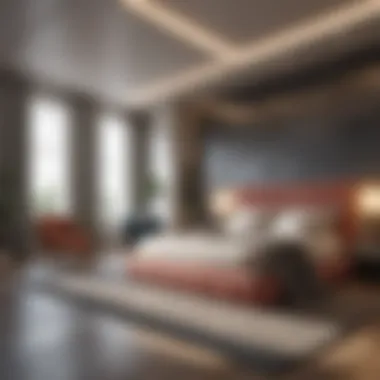
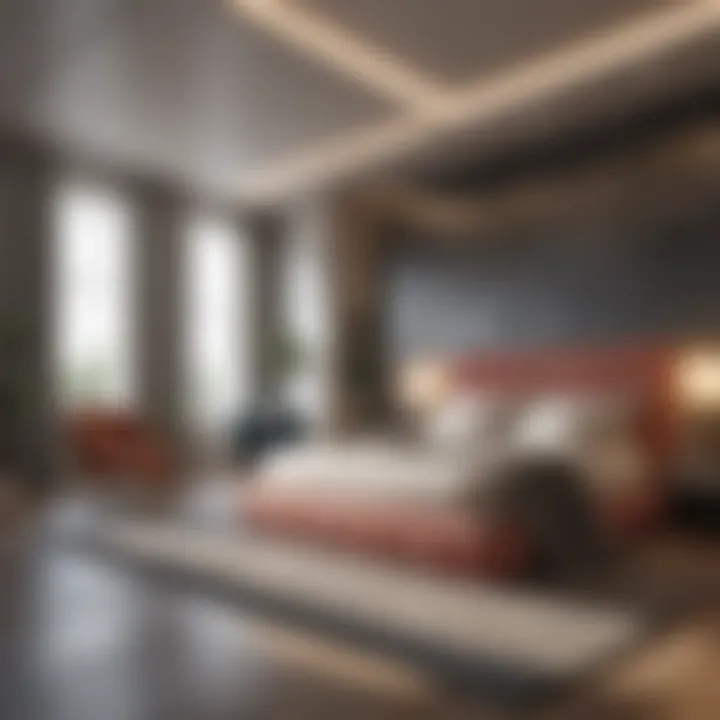
The significance of this concept lies in its ability to constantly rejuvenate the living space. Seasonal changes often bring fresh inspirations. They provide a chance to modify colors, textures, and themes that resonate with nature's shifts. For example, warm tones such as oranges and yellows may be suitable for fall, while lighter blues and greens can represent summer. This allows the bedroom to evolve over time, preventing boredom.
Benefits of Applying Seasonal Trends:
- Enhanced Atmosphere: Shift your bedroom's mood according to the seasons.
- Personal Expression: Showcase your creativity by adapting to seasonal aesthetics.
- Cost-effective Refresh: Using existing items in new ways can save money.
- Engagement with Nature: It creates a connection to the outside world and its natural patterns.
While adapting decor with seasonal changes can be enjoyable, it is essential to consider a few elements. Select items that can transition through seasons with minimal hassle. Invest in some versatile pieces that can pair well with various seasonal accents. This thoughtful planning allows you to enjoy a well-decorated bedroom year-round without extensive changes.
Adapting Decor with Seasonal Changes
Adapting your bedroom decor according to the seasons is a straightforward process. Start by evaluating existing items. Are there colors or themes that can easily be updated? Simplistic changes like switching out throw pillows or blankets can have a substantial impact.
Ideas for Seasonal Adaptations:
- Textiles: Swap out heavier fabrics for lighter ones in the spring and summer.
- Color Palette: Consider adding seasonal hues to your artwork or bedding.
- Accessories: Change decorative elements like vases or artwork to suit seasonal themes.
For winter, integrate heavier blankets and warm colors to foster a cozy atmosphere. In the summer, light materials and bright colors will make the space feel refreshing.
Key Points to Remember:
- Keep a range of accessories on hand.
- Focus on the flexibility of materials.
- Avoid clutter by rotating only a few pieces at a time.
Budget-friendly Seasonal Accessories
When considering budget-friendly seasonal accessories, it's vital to prioritize quality and affordability. Many stores offer seasonal decor items at attractive prices, but creativity also plays a key role. Look for multi-functional decor pieces that can serve during several seasons.
Accessories to Consider:
- Seasonal Artwork: Affordable prints that can be swapped in and out.
- Decorative Baskets: Utilize baskets for storing seasonal items, enhancing organization.
- Candles and Holders: Candles can change the ambiance; choose seasonal scents for added effect.
Incorporate personal DIY projects for a unique touch. For example, creating a seasonal wreath can be a fun and cost-effective way to advertise the current season. By being mindful of seasonal accessories, the overall decor can maintain freshness and relevance throughout the year.
Remember, transforming your bedroom with seasonal trends isn't about perfection. It's an enjoyable process that allows your space to evolve as you do.
Innovative Lighting Solutions
Lighting plays a crucial role in the overall aesthetics and functionality of a bedroom. It can transform a space, setting the mood and atmosphere. Innovative lighting solutions, especially those that are affordable, allow homeowners to personalize their spaces effectively. A well-lit room not only enhances visual appeal but also influences how one feels in that space. Prioritizing lighting in your budget decor plan brings added value and comfort.
Selecting Affordable Lighting Fixtures
When choosing lighting fixtures, it is essential to focus on both cost and style. Affordable options come in various forms, from pendant lights to table lamps. Consider exploring local second-hand shops, online marketplaces like Facebook Marketplace, or even thrift stores. These venues often have unique fixtures at lower prices.
When assessing fixtures, think about the type of bulbs used. Energy-efficient bulbs such as LEDs not only save money but also have a longer lifespan. Ensure the chosen fixtures complement the overall style of the room. A mismatch can disrupt the design flow, making selection even more crucial.
Here are some key points to consider when selecting lighting fixtures:
- Functionality: Identify the purpose of the lighting in the room—ambient, task, or accent lighting.
- Scale: Choose fixtures that match the size of the room and existing furniture.
- Style: Opt for designs that resonate with your taste and the overall decor theme.
Using Dimmer Switches and LED Options
Incorporating dimmer switches can maximize control over the brightness of your bedroom lighting. This feature creates flexibility, allowing you to adjust the intensity based on the time of day or activity. Lower light levels can enhance relaxation, while brighter settings are ideal for more active tasks, such as reading.
LED options further enhance this versatility. They are generally more cost-effective in the long run compared to traditional bulbs. *LEDs* come in various color temperatures, from warm white to cool daylight, offering more choices for creating the desired atmosphere.
Moreover, combining dimmer switches with LED fixtures can significantly improve energy efficiency. Homeowners notice a marked reduction in energy bills while enjoying a tailored lighting experience.
"Lighting is the key element to create a cozy and inviting bedroom. It allows for personalization without breaking the budget."
Final Touches and Personalization
In the process of bedroom decoration, the final touches and personalization hold great significance. These elements not only enhance the overall aesthetic but also contribute to a sense of comfort and identity within the space. Each choice made in this phase reflects individual style and preferences, turning an ordinary room into a personal sanctuary.
Personalization allows a homeowner to establish a unique environment that resonates with their lifestyle. The color schemes, textures, and decorative elements chosen at this stage can transform a generic bedroom into a cohesive space that tells a story about its inhabitant.
Moreover, attention to final details can consolidate the effects of prior design efforts. For instance, carefully selected artwork or family photographs add warmth and familiarity. They create a space that feels truly lived in and not merely decorated.
"Personal touches make all the difference in creating a space that feels like home."
While considering what final elements to incorporate, a few specific benefits come to mind. Personalized decor can also aid in reinforcing one's emotional well-being. A space filled with meaningful items is often comforting. Thus, investing time in this aspect is not just about aesthetics; it's about creating an environment where one feels content and relaxed.
Tailoring Decor to Reflect Personal Style
Tailoring decor to reflect personal style is a crucial step in bedroom decoration. This process involves evaluating your preferences, interests, and the emotions you wish to evoke in your space. Begin by identifying styles you are drawn to. Whether it is modern, rustic, or eclectic, knowing your aesthetic can guide your choices.
Consider the existing color palette in your bedroom. Select decor that either complements or contrasts harmoniously with the room's colors. This coordination ensures that every piece contributes positively to the overall ambience.
It is also helpful to focus on items that resonate personally. These can include souvenirs from travels, artworks that inspire, or even handcrafted items. Displaying these pieces can enrich the decor, making the space distinctly yours.
Gathering Inspiring Ideas from Various Sources
Gathering ideas for bedroom decor can come from countless sources. Magazines, social media platforms like Instagram and Pinterest, and even home improvement stores can provide endless inspiration. Online platforms often feature trends that showcase innovative designs and practical tips.
Visiting local art galleries or craft fairs can also spark creativity. Being surrounded by artistic expressions can help you see how colors and textures pair together. You might discover fabrics and materials you hadn't previously considered.
Engaging with communities on platforms such as Reddit offers further insights. You can ask for advice, share ideas, or even showcase your progress. This interaction can significantly enhance your perspective on decor possibilities.
Ultimately, the aim is to create a space that is not only visually appealing but also speaks to who you are. This personalization process strengthens the emotional connection to the bedroom, transforming it into a genuine reflection of you.















